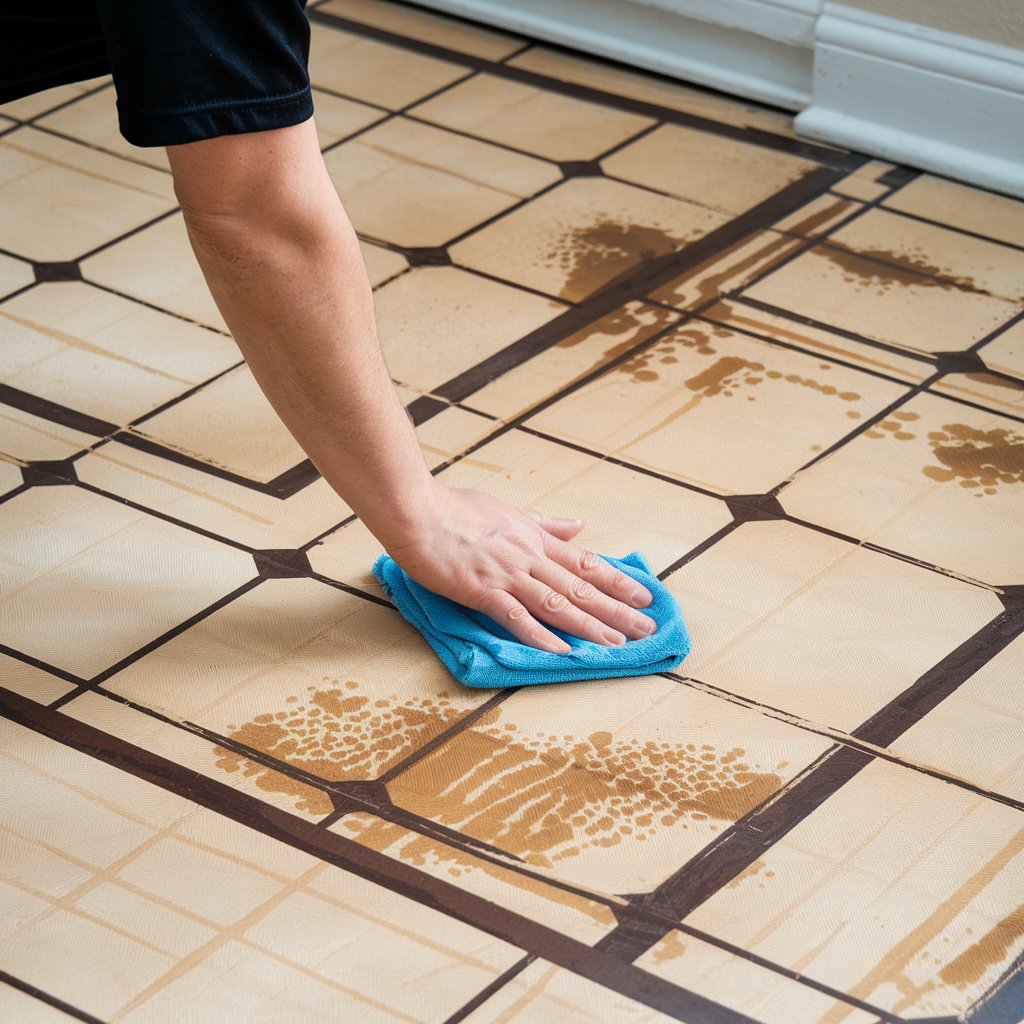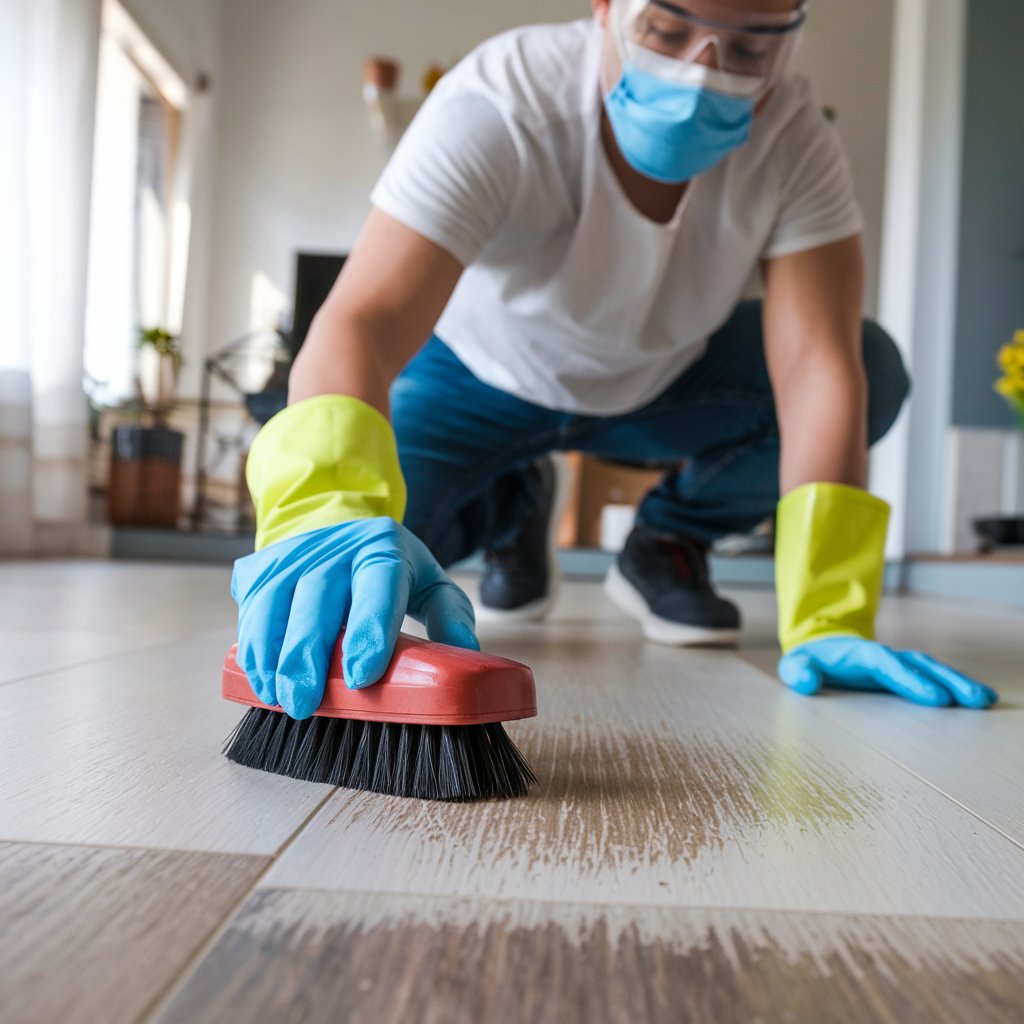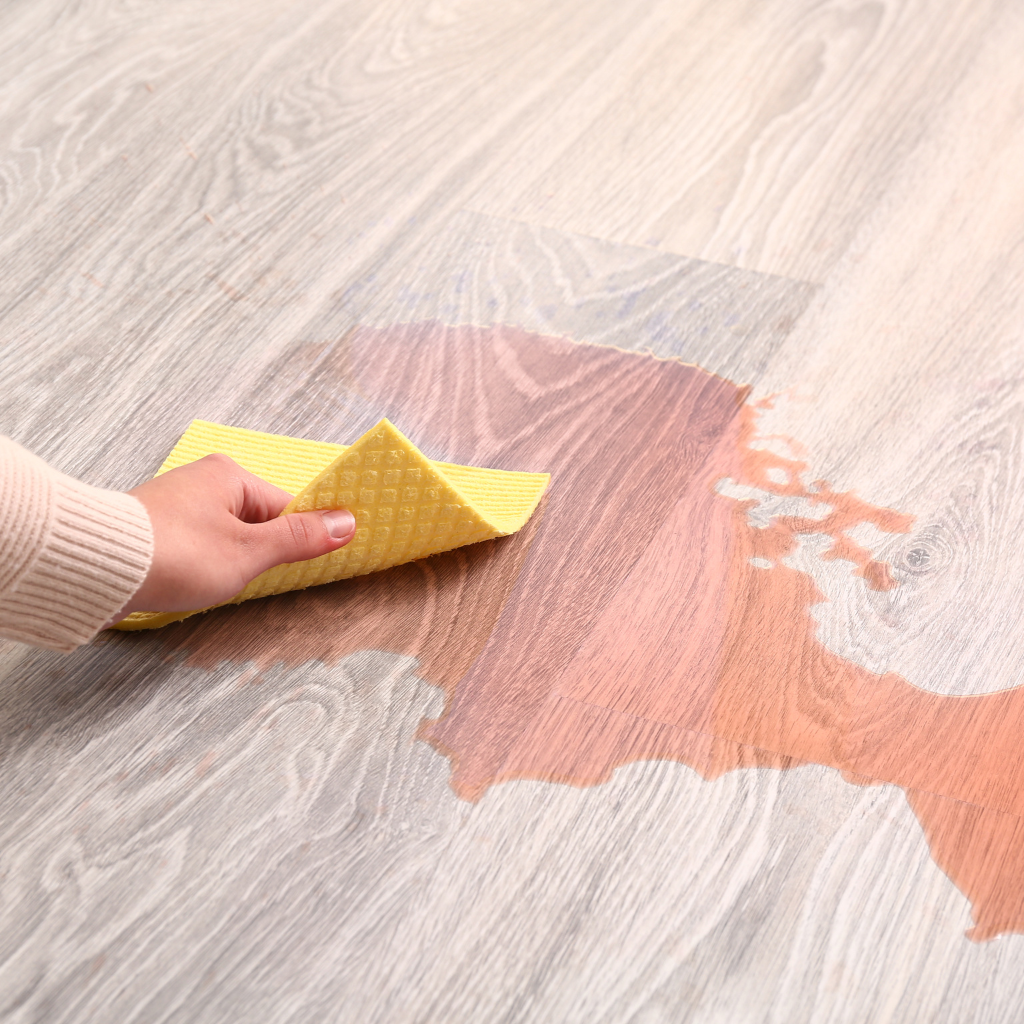
Blog test
How to Remove Stains from Laminate Flooring – The Safe and Simple Way
Removing stains from laminate flooring requires a careful choice of cleaning techniques and products to avoid damage. For ink stains, dab with rubbing alcohol. Use a vinegar-water solution for water spots, and blot spills promptly. Nail polish can be gently lifted with an appropriate remover. Employ a specialized laminate floor cleaner for routine maintenance. Prevent exposure to excess moisture, which can warp flooring. Further insights reveal additional strategies to manage and prevent stubborn stains effectively.
Key Takeaways
- Blot spills immediately with a clean cloth to prevent stains from setting into the laminate.
- Use a vinegar-water solution to clean water spots and gently prevent laminate damage.
- Apply rubbing alcohol on ink stains and blot with a damp cloth for effective removal.
- Remove stubborn marks using a baking soda paste, gently scrubbing the affected area.
- Employ microfiber cloths and damp mops for regular maintenance and stain prevention.
What are the most common Stain on laminate flooring?
Identifying the most common stains on laminate flooring is essential for effective maintenance and longevity.
Ink and water spots often result from everyday mishaps, while spills from food or beverages can cause discoloration and surface damage if not promptly addressed.
Understanding the origins and nature of these stains allows homeowners to implement targeted cleaning strategies and prevent long-term harm to their laminate floors.

Identifying Common Stains and Their Sources
Laminate flooring is susceptible to various types of stains, each with distinct characteristics and sources.
Common stains on laminate flooring include ink, spills, nail polish, and water spots. Identifying the type of stain is essential for effective stain removal.
Ink stains typically result from accidental marks or leaks from pens, requiring prompt action to prevent permanent damage.
Spills from beverages or food can leave residues that embed into the surface if not promptly cleaned.
Nail polish, often from accidental drops, can cause stubborn marks.
Water to form spots arise from prolonged exposure to moisture and can lead to warping if untreated.
Dirt and debris, although not stains per se, can become ingrained over time, complicating the cleaning process and necessitating specialized removal techniques.
Understanding Ink and Water Spots on Laminate
Ink and water spots are among the most prevalent challenges encountered on laminate flooring, each presenting unique cleaning requirements.
Both types of surface stains necessitate precise stain removal techniques to maintain the laminate’s integrity. For tougher stains like ink, utilizing a cleaning solution composed of rubbing alcohol proves effective. It is essential to blot, rather than rub, with a damp cloth to prevent spreading.
Conversely, water spots often require a different approach, with vinegar being a preferred agent for lifting these blemishes. Employing a precise application technique is essential for ideal results.
- Ink Stain Removal: Use rubbing alcohol blot with a damp cloth.
- Water Spots: Apply vinegar and gently wipe.
- Blotting Technique: Prevents stain spread.
- Surface Maintenance: Essential for long-lasting laminate flooring.
The Impact of Spills on Your Laminate Floors
Accidents happen, and when they do, spills on laminate floors can lead to a range of common stains that require different approaches for effective removal.
Coffee, wine, and juice are frequent culprits, often leaving stubborn stains on laminate flooring. Immediate action is essential; blotting the spill with a clean cloth can prevent the stain from setting.
For grease and oil spills, a solution of warm water mixed with a few drops of vinegar aids in dissolving oily residues. Baking soda can be sprinkled onto the stain for mild abrasive action and stain absorption.
Proper technique and appropriate cleaning solutions guarantee the longevity of this flooring choice. Regular maintenance not only removes stains but also preserves the aesthetic appeal of laminate surfaces.
How to Remove Stains from Laminate Flooring Effectively?
To effectively remove stains from laminate flooring, it is essential to select an appropriate cleaner specifically designed for laminate surfaces, as using incorrect products can damage the flooring.
Incorporating natural solutions such as vinegar mixed with water offers a safe and effective method for addressing less severe stains.
For more persistent stains, a systematic approach involving gentle scrubbing and the use of a laminate-safe stain remover may be required to achieve the best results.
Choosing the Right Laminate Floor Cleaner
Selecting an appropriate laminate floor cleaner is essential for maintaining the integrity and appearance of the flooring surface.
Using the right products guarantees effective stain removal on laminate flooring without causing damage.
Consider the following when choosing a laminate floor cleaner:
- Formulation: Opt for a cleaner specifically designed for laminate to guarantee appropriate cleaning.
- Application Method: Use a mop or soft cloth to wipe the stain, avoiding excess moisture gently.
- Ingredients: A mild solution of water and vinegar can be effective for cleaning laminate.
- Stain Type: For tough stains, select a cleaner that targets specific blemishes without harsh chemicals.
Using Vinegar and Other Natural Solutions
Harnessing the power of vinegar and other natural solutions can provide an efficient and eco-friendly approach to removing stains from laminate flooring.
A mixture of equal parts vinegar and water serves as an effective stain removal solution. This combination is safe for laminate flooring and is widely recognized for its ability to clean without causing damage.
Applying the solution with a damp cloth allows for gentle yet thorough application. It’s essential to blot the stain rather than rub it, preventing potential damage to the laminate surface.
For more stubborn stains, a paste of baking soda and water can be used. This paste should be applied and left for a few minutes before wiping clean.
These natural solutions guarantee a safe and effective cleaning process.
Steps for Stain Removal
While natural solutions offer an effective method for general cleaning, addressing tougher stains on laminate flooring requires special robust approach.
To tackle stubborn stains effectively, one must employ targeted stain removal techniques. Here are several recommended steps:
- Use acetone or nail polish remover: Apply a small amount onto a clean, white cloth and gently wipe the stain, guaranteeing minimal abrasion to the laminate surface.
- Dish soap solution: Mix a few drops of dish soap with warm water. Clean with a damp cloth, applying gentle pressure to lift the stain without causing damage.
- White vinegar application: Dilute white vinegar with water and use a soft cloth to treat stubborn stains.
- Repeated gentle dabbing: Persistently dab the stain, avoiding vigorous scrubbing.
These methods guarantee efficient and safe stain removal.

What Is the Best Way to Prevent Stains on Laminate Flooring?
To effectively prevent stains on laminate flooring, it is essential to implement a regular maintenance routine that includes frequent sweeping and damp mopping with microfiber cloths.
Ensuring quick response to spills and using protective pads under furniture can mitigate risks from spills and scratches.
Additionally, selecting cleaning products specifically formulated for laminate surfaces is vital to avoid chemical damage and maintain the floor’s integrity.
Regular Maintenance to Keep Your Floors Looking Their Best
Consistent maintenance is essential for preserving the pristine appearance of laminate flooring, as it greatly mitigates the risk of stains and damage.
Implementing a strategic maintenance routine helps to remove stains and keep your laminate floors looking immaculate effectively.
Experts recommend the following procedures:
- Regular Maintenance: Employ a suitable cleaner specifically designed for laminate flooring to guarantee all residues are properly removed.
- Clean Water: Use clean water for damp mopping, avoiding excessive moisture, which could warp the laminate.
- Wipe Clean: Promptly wipe clean any spills to prevent stains on laminate surfaces from setting.
- Frequent Sweeping: Floors Regularly sweep or vacuum the flooring to remove dirt and debris that can cause scratches and dull the finish.
These detailed strategies will guarantee longevity and a flawless look for laminate flooring.
Tips for Preventing Stains from Spills and Scratches
A critical aspect of maintaining the pristine condition of laminate flooring is implementing effective strategies to prevent stains from spills and scratches.
Regular cleaning is essential; promptly address spills using clean water and a soft cloth to avoid moisture seepage. Follow this by drying the floor thoroughly to prevent water damage.
To mitigate wear and tear, employ protective pads on furniture legs and use rugs in high-traffic areas. This not only reduces the risk of stains and scratches but also aids in preventing stains.
When engaging in cleaning, opt for appropriate cleaning techniques that are gentle on the laminate surface.
Using Appropriate Cleaning laminate Products
Maintaining the immaculate condition of laminate flooring goes beyond preventive measures to include the selection of suitable cleaning products.
Appropriate cleaning solutions are vital to effectively remove stains without damaging the laminate surface. Experts recommend:
- Vinegar and water: A gentle mixture that can tackle grime while preserving the flooring’s integrity.
- Nail polish remover: Utilized sparingly, this can remove stubborn stains such as ink or nail polish.
- Baking soda and water: This paste acts as a mild abrasive, ideal for lifting stains without scratching.
- Clean water and dry cloth: Essential for rinsing off cleaning agents and preventing residue buildup.
Ensuring the laminate flooring is thoroughly dried post-cleaning is imperative to prevent moisture damage and maintain its pristine appearance.
What Cleaning Solutions Are Recommended for Laminate Floors?
Selecting appropriate cleaning solutions for laminate flooring is vital to maintaining its appearance and longevity.
Commercial laminate floor cleaners are specifically formulated to remove stains without damaging the surface. In contrast, household items like baking soda offer an effective, eco-friendly alternative due to their gentle yet powerful abrasive properties. After applying any cleaner, it’s important to rinse with clean water to avoid residue that may dull the finish.
It is essential to understand the unique benefits of each option to make informed decisions that align with specific flooring needs and environmental considerations.
Top Laminate Floor Cleaner Options
Although laminate flooring is designed to be durable and easy to maintain, selecting the appropriate cleaning solution is essential to preserving its integrity and appearance. A laminate floor cleaner formulated specifically for this purpose will effectively remove stains while being water resistant.
It is vital to use clean water when diluting any solutions to avoid residue build-up. For tough stains, alcohol or nail polish remover can be cautiously used. It is important to test on an inconspicuous area first.
Recommended cleaning options include:
- Laminate-specific cleaners: Tailored for wood floors or stone finishes.
- Neutral pH solutions: Prevents damage to the floor’s coating.
- Vinegar and water mixture: Gentle and effective for regular maintenance.
- Alcohol-based solutions: Suitable for spot treatment.
Apply the solution with a soft cloth to best way to clean laminate floors efficiently.
Benefits of Baking Soda and Other Household Items
In addition to commercial cleaning products, household items like baking soda offer effective and affordable alternatives for maintaining laminate flooring.
Baking soda, a natural cleaner, excels in removing stains on laminate flooring due to its mild abrasive properties. To employ this method, create a paste by mixing baking soda with clean water, ensuring a consistent texture.
Apply the paste to the stain, gently scrubbing the area with a soft cloth to avoid damaging the surface. This safe cleaning method is suitable for tackling persistent stains without resorting to harsh chemicals.
Other household items such as vinegar and lemon juice also serve as effective cleaning solutions, offering environmentally friendly and non-toxic options for effective stain removal on laminate flooring.
How do you deal with Stubborn Stains on laminate flooring?
Addressing stubborn stains on laminate flooring requires a methodical approach involving specialized agents like rubbing alcohol and polish remover.
These agents should be applied with precision, using techniques such as gentle wiping and blotting to avoid damage to the floor’s surface.
Allowing the cleaning solution to sit for an appropriate amount of time is essential to effectively break down the stain without compromising the integrity of the laminate.
Using Rubbing Alcohol and Polish Remover
Tackling stubborn stains on laminate flooring requires a methodical approach, particularly when using rubbing alcohol and polish remover.
Begin by applying a small amount of rubbing alcohol directly onto the stain. Allow it to sit for a few minutes to break down the stain components effectively. For more resistant blemishes, a polish remover can be used, ensuring it is suitable for laminate flooring.
Follow these steps for a safe way to remove stains:
- Apply rubbing alcohol: Use a cotton pad to apply it to the stain.
- Let it sit: Allow the solution to penetrate the stain for best results.
- Rinse thoroughly: Use clean water to rinse the area, ensuring no residue remains.
- Clean the surface: Dry the laminate flooring to prevent water damage.
Techniques for Gently Wiping and Blotting Stains
Mastering the art of gently wiping and blotting stains on your laminate flooring can greatly enhance the effectiveness of stain removal efforts.
Utilizing gentle cleaning techniques is essential to avoid damaging the laminate surface. Start by using a clean, soft cloth to blot the stain, applying minimal pressure to prevent spreading. This technique is key to successful stain removal.
To remove stains from your laminate, employ an appropriate cleaning solution specifically designed for laminate surfaces. After blotting stains, rinse the area with clean water and dry thoroughly to prevent moisture damage.
Understanding how to get stains off laminate floors requires a careful approach, ensuring the use of clean materials and techniques tailored for laminate, thereby preserving the floor’s integrity and appearance.
Letting Cleaning Solutions Sit and Work
Effectively dealing with stubborn stains on laminate flooring often requires allowing cleaning solutions to sit and work. This process enables the stain remover to penetrate the stain, loosening its grip on the surface.
To effectively remove tougher stains, it is essential to follow these expert recommendations:
- Select an appropriate stain remover: Choose a solution specifically designed for laminate flooring to guarantee compatibility.
- Apply the cleaning solution evenly: Spread the stain solution over the stained area, ensuring complete coverage.
- Let the solution sit for a few minutes. Allow the cleaning agent adequate time to break down the stain.
- Gently blot and remove stains: Use a soft cloth to wipe away the loosened stain, avoiding abrasive scrubbing that could damage the surface.
This method provides a safe and simple way to deal with stains.

Conclusion
To summarize, maintaining the pristine appearance of laminate flooring requires understanding common stain sources and employing effective removal techniques. By utilizing recommended cleaning solutions and adopting preventive measures, such as immediate spill management and regular maintenance, homeowners can effectively safeguard their floors. For persistent stains, targeted approaches involving specialized products and techniques can restore laminate surfaces without causing damage. Adhering to expert advice guarantees laminate flooring remains aesthetically pleasing and durable, enhancing the longevity and value of the home environment.
-
How to Remove Stains from Laminate Flooring – The Safe and Simple Way27 Jun 2025
-
What Is the Difference Between Laminate and Vinyl Flooring Options?24 Jun 2025
-
How to Repair Scratched Laminate Flooring: Fix Scratches and Repair Tips21 Jun 2025
-
How to Install Laminate Flooring: Steps to Achieve a Perfect Floor Finish18 Jun 2025
-
How to Polish Natural Stone Floor Tiles for a Shiny Finish15 Jun 2025
-
Key Difference Between Ceramic and Porcelain Tile for Home Interiors12 Jun 2025